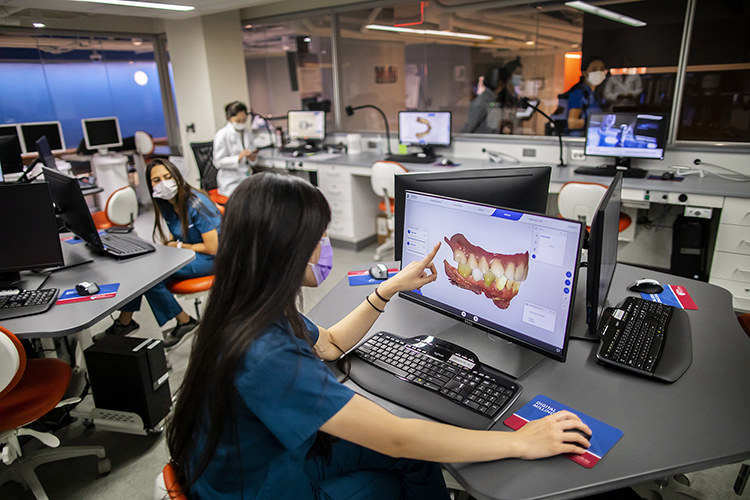Dental Medicine Enhancing and Integrating Digital Dentistry

The School of Dental Medicine’s Digital Innovation Initiative is aimed at fully integrating the latest in digital dental technologies at almost every stage of education and patient care. With state-of-the-art equipment, the new Digital Design and Milling Center and the Center for Virtual Treatment Planning, together with new staff and curriculum changes, open up possibilities for training students, conducting research and continuing education, and delivering seamless and cutting-edge patient care.
“The many types of digital technologies working together is the key to effective application and outcomes in patient care and education, and that is our goal,” says Markus Blatz, Professor and Chair of Preventive and Restorative Sciences and Assistant Dean for Digital Innovation and Professional Development. Dr. Blatz has championed and leads the school’s Digital Innovation Initiative.
“Scanning teeth with optical scanners and fabricating dental restorations with digital technologies has become very common. Now, we have additional technologies, from electronic health records to face scans, that help us right from the beginning, with diagnostics, treatment planning, and restoration design,” he added. “All this information interconnects, making it much easier to include all dental specialties and even artificial intelligence tools in the treatment planning process. This, I think, is one of the big advantages of digital dentistry.”
The Digital Design and Milling Center is focused on chairside CAD/CAM applications. While the facilities were temporarily closed due to the COVID-19 pandemic, they are now back up and running, welcoming students who work in a socially distanced fashion.
The Digital Design and Milling Center features 12 computers/design PCs loaded with three types of software for different applications: one for designing and milling single-unit restorations like inlays, crowns, and veneers; another for implant-related restorations and surgical planning; and a third laboratory-oriented program for digital wax-ups, which are planning models for restorations. Recently the school acquired new printers with 3D capabilities that can print up to 40 different materials. In addition, 10 high-speed milling machines line one wall of the Center to produce restorations, and eight ceramic furnaces are used to fire and finish them.
While many long-established private dental practices may not yet embrace digital dentistry, it’s clear that it’s the way of the future, and as part of the Digital Innovation Initiative, both the predoctoral and postdoctoral curriculum have been adjusted to incorporate experience with CAD/CAM technology. Even first- and second-year students are now learning to use intraoral scanners in the preclinical simulation labs, scanning mannequin mouths as they simulate procedures to begin refining their techniques before entering the clinic. By the time students reach their third and fourth years, they’ll be ready to apply these techniques in patient care.
To ensure that Penn Dental Medicine’s technological resources and techniques are the finest available, faculty and students are engaged in research projects to identify best practices and provide feedback to industry partners to continue refining their products. In the future, faculty envision every patient coming through admissions will be scanned. And though some may believe that a greater use of technology means less personal care, Dr. Blatz underscores the opposite is the case.
“Some people think that with CAD/CAM technologies, everyone is getting the same smile, but in fact we can individualize care like never before. And by using scan files of natural dentition to design and restore teeth and smiles, the outcomes look and function in a truly natural manner,” he says. “With costs coming down and these technologies becoming more accessible, my hope is that ultimately, patients’ access to high-quality oral health care and customized dental restorations that look nice, that are well-fitting, and that have quality materials will be greatly improved. That is the goal.”
Adapted from a November 24, 2020, story by Katherine Unger Baillie in Penn Today. Read the full text at https://penntoday.upenn.edu/news/embracing-digital-dentistry
